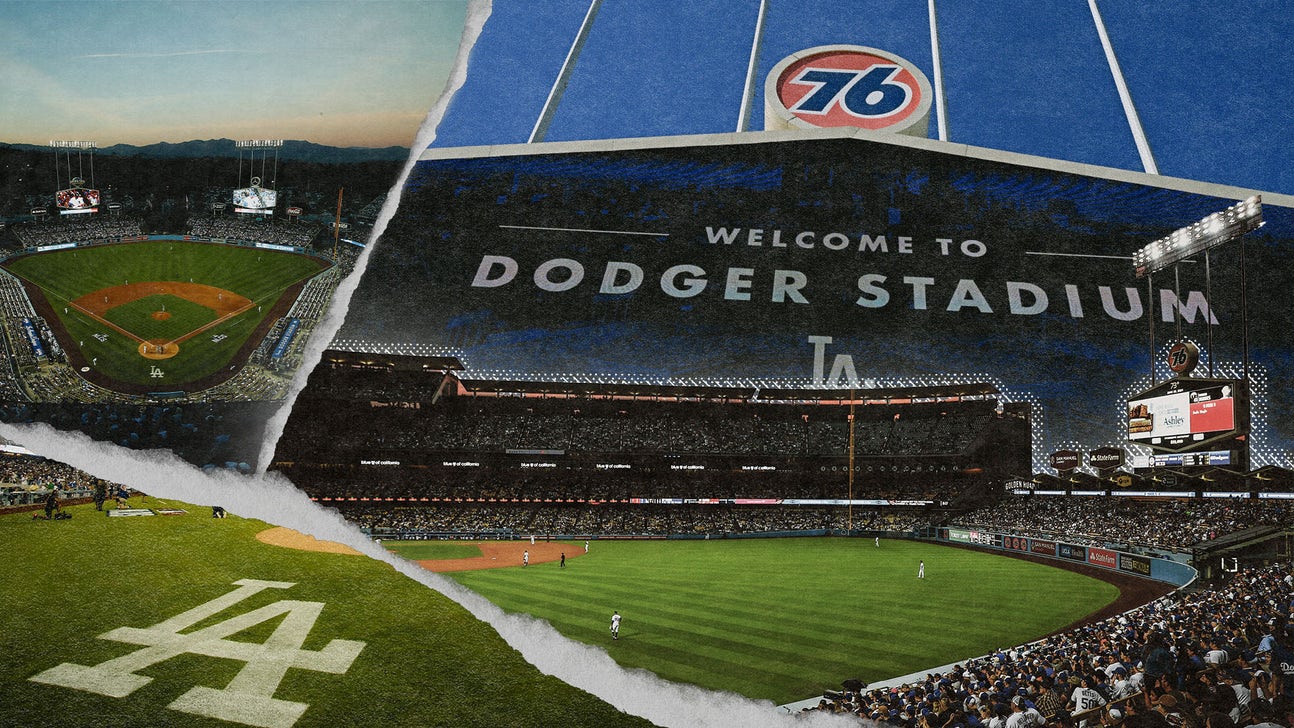
MLB All-Star Game 2022: Dodger Stadium remains a classic, with a modern touch
By Rowan Kavner
FOX Sports MLB Writer
LOS ANGELES — Sixty years after Walter O’Malley’s majestic vision came to life, Dodger Stadium continues adding to its grand résumé.
In addition to welcoming more than 178 million Dodgers fans since opening its doors in 1962, the venue has hosted soccer, hockey and rugby matches, mass for Pope John Paul II, Harlem Globetrotters basketball, the World Baseball Classic and concerts for The Beatles, Elton John and Bruce Springsteen.
On Tuesday, for the first time since 1980 and just the second time in its existence, it will serve as the site of Major League Baseball’s All-Star Game (8 p.m. ET on FOX and the FOX Sports app).
"This is such a great place to play, and I think everybody knows that," Dodgers pitcher Clayton Kershaw said. "All the road teams that come in and get to play here, they say what a great place Dodger Stadium is. We’re excited to share it."
MLB All-Star Game: An exclusive tour of Dodger Stadium
The occasion provides an opportunity to showcase to a national audience the modern amenities recently added to MLB’s third-oldest ballpark.
The $100 million enhancements that brought an expansive Centerfield Plaza and new elevators, escalators and bridges to Dodger Stadium ahead of the 2020 season haven’t sacrificed the historic ballpark’s classic feel — from its top deck views of the San Gabriel Mountains and Los Angeles skyline to its mid-century modern architecture, hexagonal scoreboards and colorful seats reminiscent of a California sunset.
"It’s an iconic space in L.A., and I think most people consider it their home away from home," said Justin Turner, who grew up in Southern California and attended high school in nearby Lakewood. "It’s deeply embedded into the roots of L.A. and the people who grew up here."
Turner still recalls his grandmother taking vacations to watch the progress O’Malley and architect Emil Praeger made as Dodger Stadium was being built in the late ‘50s and early ‘60s.
Following negotiations with Los Angeles city officials, O’Malley moved the Dodgers from New York to California in 1958 — three years after Brooklyn won its lone World Series championship.
"His critics say, ‘He was going to go to California anyway, he had no interest in Brooklyn — not true," said Peter O’Malley, Walter’s son, who would later inherit the team. "It was only when he saw he couldn’t do it in New York — and he wanted to privately finance it, he wanted to design it, he wanted to do it his way — that he realized, ‘I can’t make it go there, so I’ve got to go elsewhere.’"
As the new stadium was being constructed, the Dodgers spent their first four seasons on the West Coast at the Los Angeles Memorial Coliseum, which featured distinct dimensions of 250 feet out to left field and a whopping 440 feet to right.
A more typical hitting experience awaited at Chavez Ravine, where eight million cubic yards of dirt were moved to create a ballpark in the hillside. A casting yard in center field held more than 25,000 precast concrete segments, which were put in place by a $150,000 crane used to assemble Dodger Stadium.
Some of the elements Walter O’Malley once envisioned, including a fountain in center field, never came to fruition. But his dream was realized on April 10, 1962, when Dodger Stadium debuted. The Dodgers led all MLB teams in attendance that year, with 2,755,184 fans. Fans continued flocking as Sandy Koufax helped the club to its third and fourth World Series titles in 1963 and 1965.
Six decades later, it’s clear the venue isn’t going anywhere anytime soon.
With a capacity of 56,000, Dodger Stadium has paced the major leagues in attendance each of the past eight full seasons (not including the pandemic-shortened 2020 season, which featured only cardboard cutouts) and set a franchise record of 3,974,309 fans in 2019. Even in 2021, with the first 33 games played in front of a limited-capacity crowd, nearly three million people made their way through.
"It’s such a great statement about what we mean to the city and what the city means to us," said Stan Kasten, Dodgers president and CEO. "Without the fans’ support, we couldn’t have the revenues to keep building this team and the facility that we have."
The experience has been guided by Guggenheim Baseball Management, which poured funds into bolstering both the product on the field — the Dodgers have made the playoffs nine straight seasons — and the stadium itself. The latest enhancements were overseen by executive vice president of planning and development Janet Marie Smith, whose previous experience included the supervision of Oriole Park at Camden Yards and the expansion of Fenway Park.
In 2013, Smith’s work modernizing the ballpark included new video and sound systems, retail stores, kids play areas, standing-room sections and ADA seating. The video boards over the pavilions were enlarged by 22% and restored to hexagonal shapes. Plazas on the top deck and reserve levels added more space, providing room for retired numbers and life-sized bobbleheads.
Instead of hosting a museum at the stadium, the entire stadium became a museum (it is also a botanical garden, earning accreditation for its drought-resistant plants throughout the grounds).
"Everywhere you turn, there’s something that tells the story of the Dodgers and the team’s relationship with Southern California," Smith said. "Buildings become a story."
Displays are dedicated to Gil Hodges, who became a Hall of Famer this year, and Jaime Jarrín, who is in his final season as the Spanish-language voice of the Dodgers. Jackie Robinson’s 75th anniversary season is recognized with mementos throughout the stadium and a "Barrier Breakers" exhibit on loan from the Negro Leagues Baseball Museum. Another exhibit, "Baseball’s Bridge to the Pacific," celebrates the role baseball has played between the United States and Japan.
Among the artifacts and memorabilia throughout the ballpark are Gold Glove, MVP and Cy Young Awards, as well as World Series trophies, which players walk past each day on their way to the clubhouse. On the field level, the Baseline Club on the first-base side includes bats from every Los Angeles All-Star, while another on the third-base side features a collection of 1,000 baseball bobbleheads.
There are tributes to Fernandomania and the late Tommy Lasorda — Lasorda himself curated much of the memorabilia — and recognitions of Dodger Hall of Famers and "Legends of Dodger Baseball." Recently, Smith found drawings in the office of Peter O’Malley, which had been designed in 1959 but never created. She had them built and used as hexagonal signs over the staircases.
"As we see the way fans have responded to the things we put out, it just encourages us to want to do more," she said.
One of the stadium’s most striking overhauls took place ahead of the 2020 season, when the Dodgers were originally tabbed to host the All-Star Game. A new, two-acre Centerfield Plaza gave Dodger Stadium the front door it never previously had and eventually became home to the Robinson statue — which was constructed in 2017 — and a Koufax statue that was unveiled earlier this year.
A Gold Glove Bar brings direct views to the home bullpen, while a speakeasy provides a peek into the visiting bullpen. Fans are also closer to the action in the outfield, where they can now watch batting practice behind the warning track or sit in home run seats, which replaced exit stairs at the front of the pavilions.
The latest renovations make Dodger Stadium easier to navigate, providing 360-degree access to the ballpark, which still features one of the most picturesque views of Los Angeles from its peak.
"The No. 1 thing I would do is go to the top of the park and take in the view of Dodger Stadium from that incredible vantage point, 110 feet above the playing field, looking out over the playing field in the foreground, Elysian Park itself sort of center stage and the San Gabriel Mountains beyond," Smith said. "There’s just nothing like it in sports. It’s such a magical place."
Rowan Kavner covers the Dodgers and NL West for FOX Sports. A proud LSU alumnus, he credits his time as a sportswriter and editor at The Daily Reveille for preparing him for a career covering the NFL, NBA and MLB. Prior to joining FOX, he worked as the Dodgers’ editor of digital and print publications. When not at a stadium or watching sports, Rowan enjoys playing with his dog, hiking, running, golfing and reminiscing about the Mavs’ 2011 championship run. You can find him on Twitter at @RowanKavner.











